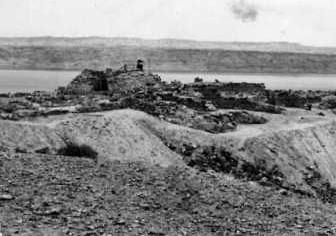 The date of November 29th 1947 is well-known as the day the UN approved the UNSCOP recommendation to establish two states in Palestine. (For more information about the Partition Plan, kept at the CZA click here ). On the same day, in a rare coincidence, Professor Elazar Sukenik examined a piece of an ancient scroll that was found by a Bedouin shepherd and decided to buy it. One of the major archeological discoveries of the 20th century was revealed.
The date of November 29th 1947 is well-known as the day the UN approved the UNSCOP recommendation to establish two states in Palestine. (For more information about the Partition Plan, kept at the CZA click here ). On the same day, in a rare coincidence, Professor Elazar Sukenik examined a piece of an ancient scroll that was found by a Bedouin shepherd and decided to buy it. One of the major archeological discoveries of the 20th century was revealed.
The story of the discovery of the scrolls seems as if it was taken straight out of a Hollywood script. Bedouin shepherds found jars inside a cave that contained old scrolls. They tried to sell them to various people, including antique dealers. One of the antique dealers showed a part of a scroll to Professor Sukenik, who was the head of the Archeological Department at the Hebrew University. Sukenik realized at once the real value of the finding and wanted to purchase the scrolls from the Bedouins. He managed to buy three scrolls before the War of Independence started. Other scrolls that were found, were sold to other parties. The State of Israel managed to purchase some of them after the War.
This story, taken from a lecture given by Yigael Yadin, the son of Professor Sukenik, reflects the tension that the Jews felt at the time. When Professor Sukenik realized he would have to go to Bethlehem in order to buy the scrolls, he consulted with his son.
Even after Professor Sukenik had bought the scrolls, the difficulties did not end. Jerusalem was under siege and Professor Sukenik had to translate the scrolls under harsh conditions. He writes in his diary that during the work of deciphering the scrolls, they heard artillery and mortar fire of the enemy. It felt as though the scrolls were not telling the story of a distant past, but the story of the present. The scrolls gave them some comfort in those difficult times.
Following the discovery of the scrolls in a cave at Qumran, Bedouins who lived in the area searched for more scrolls in order to sell them. Additional findings led groups of local and international archaeologists to begin searches in the Judean Desert. Between the years 1947-1956 more scrolls were found hidden in 11 caves near the Qumran remains. The scrolls were dated from the first and second centuries BC. There are very few sources from that time, and it is for that reason that the scrolls are so important. Due to the dry climate around the Dead Sea, the scrolls were preserved almost intact. The first seven scrolls that were found are displayed at the Shrine of the Book at the Israel Museum.